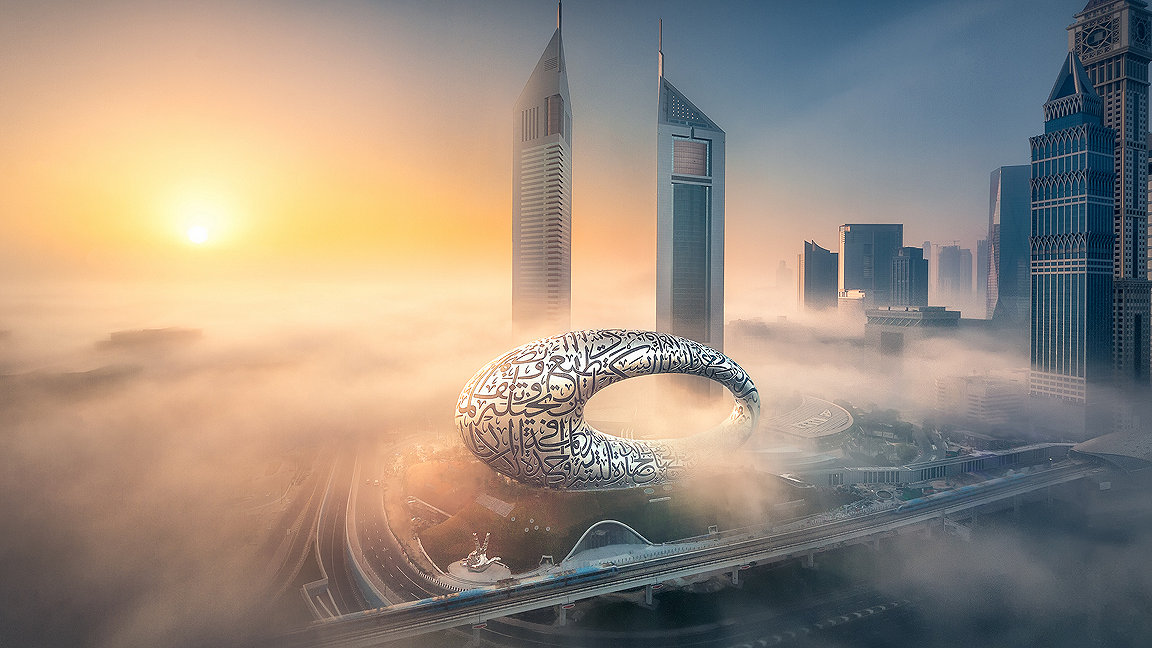
Dubai is a city jam-packed with eye catching skyscrapers like the soaring Burj Khalifa and a plethora of spectacular attractions.
It takes a special building to stand out. Something like the Museum of the Future. The glimmering seven-storey building, created to house the UAE state’s vision of the world in 2071, only opened in February 2022 but has already garnered international praise and awards, and attracted 1m visitors from 163 countries.
“If you take a look at the Museum of the Future, every element from its oval shape to the Arabic calligraphy that wraps the exterior is refreshingly different from the gleaming skyscrapers that line the Sheikh Zayed Road where it is located,” says Swapnil Pillai, associate director, Savills Middle East Research. “The idea behind the structure itself … aims to attract visionaries and futurists to help shape the world of tomorrow.”
After its inauguration in 2015 by Sheikh Mohammed bin Rashid Al Maktoum, Dubai ruler and UAE vice president, several temporary versions of the museum appeared at the Madinat Jumeriah during the World Summit from 2016 to 2018. The museum officially opened in its current state in February 2022.
The mission of the museum is to explore near-future technologies and promote development and innovation – especially with artificial intelligence and robotics from leading global innovators. Visitors are taken on a journey to what life could be like in 2071.
Along with innovations, it is a hub to bring researchers, designers, inventors, and financiers under one roof.

“Every element, from its oval shape to the Arabic calligraphy that wraps the exterior, is refreshingly different” Swapnil Pillai, Savills Middle East Research


‘Instant icon status’
The museum is within the grounds of the Emirates Towers, completed in 1999, which are themselves considered Dubai landmarks. “Adding something in close proximity to the Emirates Towers would have been, I imagine, a delicate selection,” says Faisal Durrani, partner and head of Middle East research at Knight Frank. “But they managed to put [a building] in that doesn’t compete with [the two] towers but complements them. It’s got instant icon status.”
This is also the home to the world’s first fully functional 3D printed office building. At 2,700ft2, the Office of the Future, which opened in 2016, was the first major project of the museum. It is the headquarters of the Dubai Future Foundation, where young international entrepreneurs come to pitch ideas to solve global issues.
“They work with the government to try and bring those ideas to life,” says Durrani. “Emirates Towers, and the grounds, are sort of a centre of innovation.” Change is already evident, with over 200 AI start-ups operating in the city, while Dubai’s 2040 Urban Master Plan envisions The Loop, a climate-controlled, pedestrian highway with innovative kinetic flooring.
“The museum will continue to serve as a catalyst for a greater tilt towards the technologies of tomorrow,” says Jacqueline Johns, principal at Christie’s International Real Estate, Dubai.
“That play on the collision of museum and future are not two things you would normally put side by side” Faisal Durrani, Knight Frank



“The museum will continue to serve as a catalyst for a greater tilt towards the technologies of tomorrow” Jacqueline Johns, Christie’s International Real Estate

A unique shape
It is the shape and design by Killa Design architects, and engineered by Buro Happold, that sets it apart from all of Dubai’s other buildings.
The Museum of the Future’s website describes its form as “futuristic” and “symbolic,” stating: “The circular building represents humanity; the green mound it sits atop represents the earth; the void represents the unknown future.”
The green mound was also practical. “Putting it on a hill elevates it so the bottom of the museum was sitting parallel to the monorail that runs right across the front. If they hadn’t done that the monorail would have obscured it from the highway,” says Durrani.
The crowning glory is the torus-shaped shell, whose exterior is made of over 1,000 fire-retardant composite panels clad in stainless steel. Each panel has a unique 3D shape to create the Arabic calligraphy etched into the façade, which also lets in light.

Of the three quotes composed by Sheikh Mohammed, Durrani says: “One of my favourite phrases on the building is, ‘the future belongs to those who can imagine it, design it, and execute it. It isn’t something you await, but rather create.’ It’s very apt for a structure like that.”
This is Dubai’s mantra, says Durrani, to be the most forward-thinking place in the world, and to cement its position as the most futuristic city. “That play on the collision of museum and future are not two things you would normally put side by side. It’s been designed in such a way that it allows technology that is still being developed and in an embryonic stage to be showcased,” he says.
As the innovation within the city keeps on going, Durrani adds: “Dubai has always managed to find the next big thing.”

